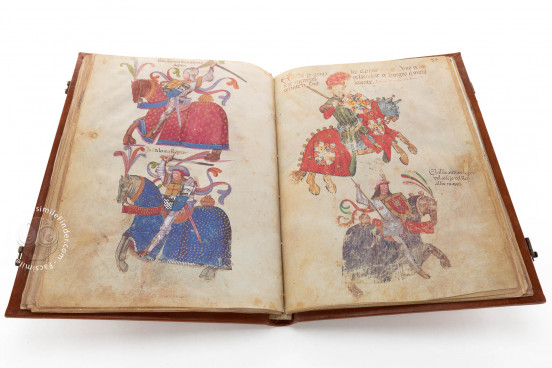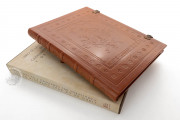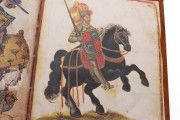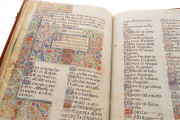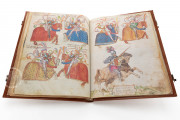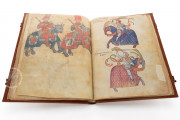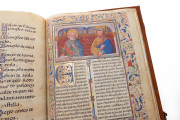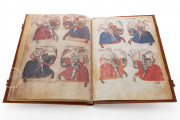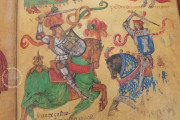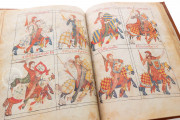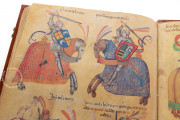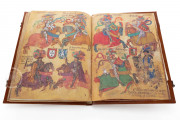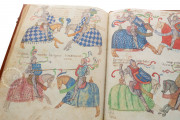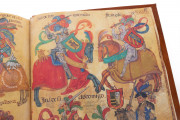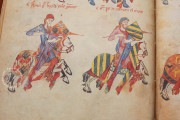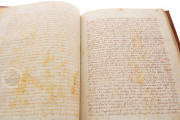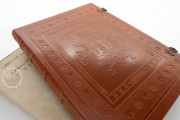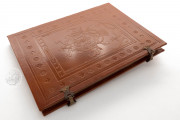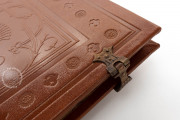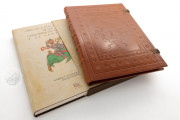The Book of the Knights of the Brotherhood of Santiago is the oldest surviving pictorial equestrian armorial. But it is more: it includes copies of the statutes of the brotherhood (of the town of Burgos), both upon its foundation in 1338 and its reform in 1501, as well as additions to the armorial dating from the sixteenth and seventeenth centuries. More than 300 knights of the brotherhood are pictured (one, two, three, or four to a page).
An armorial is a collection of images of heraldic arms. Each portrait in the Book of the Knights depicts the knight mounted on a horse and bearing a weapon—usually a sword or spear—and a shield emblazoned with his coat of arms. The knight's heraldry is also shown on his horse's caparison, an embroidered cloth cape.
Patron Saints
Each of two versions of the Christian brotherhood's statutes—those of 1338 and those of 1501—is introduced by a miniature. The first, painted in the Gothic style of the fourteenth century, shows Christ enthroned and displaying the wounds of the Crucifixion. Angels hold instruments of the Passion: nails, cross, spear, and flagellum (fol. 14r).
The miniature heading the reformed statutes (fol. 59r), painted in the Renaissance style of the turn of the sixteenth century, shows Saint Peter and Saint James the Greater (in Spanish, Santiago). Curiously, the keys of Saint Peter have been rendered as a pair of arrows.
Crosses, Castles, Stars, and Shells
Much of the manuscript's visual interest lies in the heraldry of the knights, which is rendered in a brilliant array of colors. The coats of arms feature crosses of many sorts, with the arms terminating in three knobs or fleurs-de-lis. Less common is the Occitan cross with hollow splayed arms ending in three small balls (e.g., on the shields of Johán and Bernal Rremont on fol. 27r).
The scallop shell, the emblem of Saint James, figures prominently on many of the knights' coats of arms. There are also castles and stars in a variety of shapes. Among the animals are lions, leopards, wolves, deer, and bulls.
Plate Armor and Plumed Helmets
Several artists contributed to the armorial over the centuries. In the portion of the armorial created in the fourteenth century (fols. 21-53), the horses with their brightly colored caparisons dominate each representation. The knights wear robes and simple caps but no armor. In the armorial of the sixteenth and seventeenth centuries (fols. 68r-93r), the knights are often presented astride their horses in plate armor and wearing helmets that feature colorful feathers.
A Composite Manuscript
At the end of the seventeenth century, notarial copies of documents dating from around 1400 (fols. 1-13) were bound together with the statutes, three lists of knights of the brotherhood, and the two extensive sections of equestrian portraits. Four scribes wrote the documents, including Gonzalo García de Medina de Pomar. The composite codex has since lost more than twenty leaves.
We have 1 facsimile edition of the manuscript "Book of the Knights of the Brotherhood of Santiago": Libro de los Caballeros de Santiago facsimile edition, published by Siloé, arte y bibliofilia, 2001
Request Info / Price
